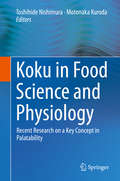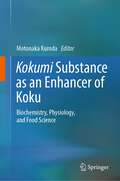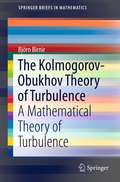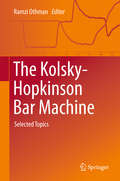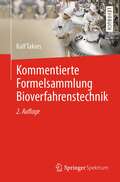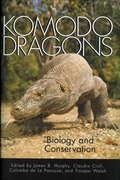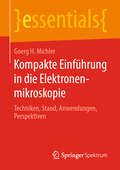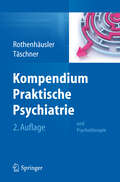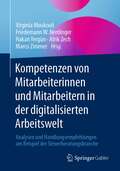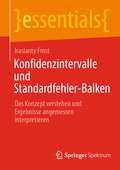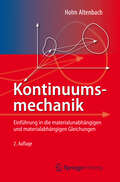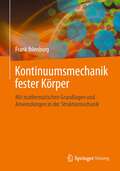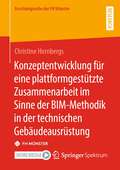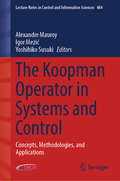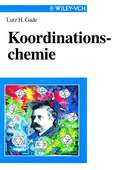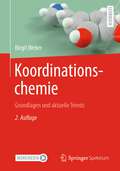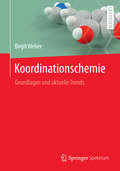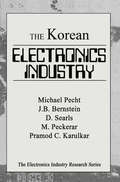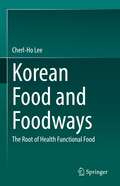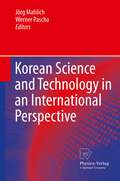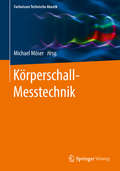- Table View
- List View
Koku in Food Science and Physiology: Recent Research on a Key Concept in Palatability
by Toshihide Nishimura Motonaka KurodaThis is the first book to explore the science underlying the concept of “koku”, which is central to an understanding of the palatability of food within Japanese cuisine and is attracting increasing interest among food scientists and professionals worldwide. Koku may be defined as the sensation that results from the complexity of the food (i.e., its richness or body), its lingering aftertaste or persistence, and its heartiness in terms of taste, aroma, and texture. A variety of substances have been found to impact significantly on koku, including umami substances, phytosterols, certain aromatic compounds, and kokumi substances. In Koku – Food Science and Physiology, readers will find full explanation of the conceptual aspects and the latest research results on a wide range of topics, including the relevant flavor chemistry and sensory analysis. Written by leading scientists in the field, the book will be a valuable resource for students and researchers in the fields of food chemistry, nutritional science, taste physiology, and neuroscience, as well as for professionals in the food industry.
Kokumi Substance as an Enhancer of Koku: Biochemistry, Physiology, and Food Science
by Motonaka KurodaThis book provides the basic concepts and latest findings on kokumi substances. It covers not only the topics related to food chemistry, but also the biochemical and physiological mechanisms of the perception of kokumi substances. Food palatability is determined by many factors, including taste, aroma, texture, color, physiological condition, and circumstances. The attribute called “koku” is used in Japan to express delicious foods. The definition of koku attribute was previously proposed to be caused by the sensation of richness, body, lingering (continuity), and mouthfulness in terms of taste, aroma, and texture. Kokumi substance is one of the taste-related koku enhancers and is defined as a substance that enhances complexity, richness (body), and lastingness (continuity), although it has no taste itself at the dose. The topics in this book cover physiological studies, including the receptor mechanism, taste nerve recording, and human brain responses using functional MRI. It also discusses the sensory characteristics of kokumi substances when added to foods and the effect of kokumi substances on the satiety. The intended readers are university students, researchers and technologists in food science, food chemistry, nutritional sciences, taste physiology, and neuroscience. Non-expert readers interested in food palatability and the deliciousness of foods may also find this book useful.
The Kolmogorov-Obukhov Theory of Turbulence
by Bjorn BirnirTurbulence is a major problem facing modern societies. It makes airline passengers return to their seats and fasten their seatbelts but it also creates drag on the aircraft that causes it to use more fuel and create more pollution. The same applies to cars, ships and the space shuttle. The mathematical theory of turbulence has been an unsolved problems for 500 years and the development of the statistical theory of the Navier-Stokes equations describes turbulent flow has been an open problem. The Kolmogorov-Obukhov Theory of Turbulence develops a statistical theory of turbulence from the stochastic Navier-Stokes equation and the physical theory, that was proposed by Kolmogorov and Obukhov in 1941. The statistical theory of turbulence shows that the noise in developed turbulence is a general form which can be used to present a mathematical model for the stochastic Navier-Stokes equation. The statistical theory of the stochastic Navier-Stokes equation is developed in a pedagogical manner and shown to imply the Kolmogorov-Obukhov statistical theory. This book looks at a new mathematical theory in turbulence which may lead to many new developments in vorticity and Lagrangian turbulence. But even more importantly it may produce a systematic way of improving direct Navier-Stokes simulations and lead to a major jump in the technology both preventing and utilizing turbulence.
Kolmogorov-Zakharov Spectra of Turbulence: Wave Turbulence (Graduate Texts in Physics)
by Vladimir Zakharov Victor Lvov Gregory FalkovichStarting at the level of graduate students, this book offers a comprehensive introduction to a rapidly developing field of turbulence. It also presents the state of the art of the theory of wave turbulence in diverse media for researchers looking for a formalism to solve existing problems or for new research subjects and ideas. The book provides a general theory of developed wave turbulence in different media: plasmas, solids, atmosphere, oceans and space. The presentation starts with a simple and intuitive dimensional analysis and proceeds to a rigorous analytic theory with exact solutions for the stationary spectra of turbulence, stability theory of such spectra, description of nonstationary regimes and matching spectra with pumping and dissipation regions. The reader is provided with the necessary tools to study nonlinear waves and turbulence: Hamiltonian formalism, statistical description, derivation of kinetics equations and methods of finding their steady and non-steady solutions. In this second edition the book is brought up to date both in theoretical and experimental/observational aspects. In particular, the authors have updated and revised the description of nonstationary turbulence, turbulent entropy production, etc, and added discussions of master equation and several cases of strong turbulence and nonlocal cascades. The book now includes excercises, some with solutions.
The Kolsky-Hopkinson Bar Machine: Selected Topics
by Ramzi OthmanIn this book, leading scientists share their vision on the Kolsky-Hopkinson bar technique, which is a well-established experimental technique widely used to characterize materials and structures under dynamic, impact and explosion loads. Indeed, the Kolsky-Hopkinson bar machine is not a simple experimental device. It is rather a philosophical approach to solve the problem of measuring impact events. The split Hopkinson pressure bar conventional device is mainly limited to test homogeneous ductile non-soft materials under uni-axial compression. Extending the use of this device to more versatile applications faces several challenges such as controlling the stress state within the specimen and mastering the measurement of forces and velocities at the specimen-bar interfaces and then the material properties. Thus, the topics discussed in this book mainly focused on the loading and processing parts.
Kommentierte Formelsammlung Bioverfahrenstechnik
by Ralf TakorsDie kommentierte Formelsammlung bietet einen schnellen und umfassenden Überblick über unterschiedlichste Aspekte der Bioverfahrenstechnik, wie zum Beispiel wichtige chemische Gleichungen, Enzymkinetiken oder Stoff- und Wärmetransporte, um nur einige wenige Themen zu nennen. Darüber hinaus wird die Entwicklungskette von ersten Laborversuchen bis hin zum Scale-up und der wirtschaftlichen Analyse entsprechender Prozesse für Leser übersichtlich zusammengefasst. In der neuen 2. Auflage sind neben inhaltlichen Erweiterungen der oben genannten Themen auch Stoffwechselschemata Industrie-relevanter Mikroorganismen und Säugerzellen zusammengestellt, die für Produktionszwecke eingesetzt werden. Motiviert durch eigene Erfahrungen im akademischen und industriellen Bereich wurde dieses kleine Nachschlagewerk erstellt. Es soll denjenigen, die mit unterschiedlichen Aufgaben in der Forschung und Entwicklung betraut sind, als schnell verfügbare Quelle zur Problemlösung zur Verfügung stehen. Darüber hinaus kann es auch Studierenden als Leitfaden für die Ausbildung im Bereich Bioverfahrenstechnik dienen.
Komodo Dragons
by James B. Murphy Colomba de La Panouse Claudio Ciofi Trooper WalshMore than twenty years have passed since Walter Auffenberg's monumental The Behavioral Ecology of the Komodo Monitor. In the intervening years the populations of Komodo dragons--native only to a handful of islands in southeast Indonesia--have dwindled, sparking intensive conservation efforts. During the last two decades new information about these formidable predators has emerged, and the most important findings are clearly presented here.A memoir from Walter Auffenberg and his son Kurt is followed by the latest information on Komodo dragon biology, ecology, population distribution, and behavior. The second part of the book is dedicated to step-by-step management and conservation techniques, both for wild and captive dragons. This successful model is a useful template for the conservation of other endangered species as well, for, as Kurt and Walter Auffenberg note, "The species may well indeed survive in the wild for generations to come while countless other organisms are lost."
Komodo Dragons (Nature's Children)
by Geoff MillerCan Komodo dragons breathe fire? How many teeth do Komodo dragons have? What do young Komodo dragons look like? Find the answers to these questions, and learn much more about the physical characteristics, behavior, habitat, and lives of Komodo dragons. Other books in this series are available in this library.
Kompakte Einführung in die Elektronenmikroskopie: Techniken, Stand, Anwendungen, Perspektiven (essentials)
by Goerg H. MichlerGoerg Michler fasst das große Gebiet der Elektronenmikroskopie zusammen und stellt die verschiedenen Techniken übersichtlich dar. Der Autor beschreibt anschaulich die Einsatzmöglichkeiten der Mikroskopie und die Anforderungen an eine Probenpräparation. Mit Bildbeispielen aus der Praxis illustriert er die Darstellungen.Der Autor: Prof. Dr. rer. nat. habil. Goerg H. Michler war Leiter des Instituts für Werkstoffwissenschaften an der Martin-Luther-Universität Halle-Wittenberg, ist Ehrenvorsitzender des Instituts für Polymerwerkstoffe e.V. und Vorsitzender der Heinz-Bethge-Stiftung für angewandte Elektronenmikroskopie.
Kompaktwissen Gefäßmedizin: Gefäßchirurgie, Angiologie und endovaskuläre Medizin
by Bernd Luther Knut Kröger Marcus KatohDer Band präsentiert gefäßchirurgisches Faktenwissen kompakt und übersichtlich: Diagnostisches Vorgehen, Therapiestrategien, prognostische Faktoren und mögliche Komplikationen werden von renommierten Experten präzise in Stichworten und Tabellen dargestellt. Dabei werden alle Gefäßregionen und klinisch wichtigen Fragestellungen mit einbezogen. Die Neuauflage geht verstärkt auf endovaskuläre Verfahren ein, sie enthält anschauliche Handlungsleitfäden sowie ein zusätzliches Kapitel über gefäßchirurgische Begutachtung.
Kompendium Praktische Psychiatrie
by Karl-Ludwig Täschner Hans-Bernd RothenhäuslerDas Fachbuch für Studium und Praxis bietet eine übersichtliche Einführung in Psychiatrie und Psychotherapie. Dargestellt werden das Arbeitsfeld der Psychiatrie, die psychopathologische Befunderhebung, diagnostische und therapeutische Prinzipien sowie die psychiatrischen Krankheitsbilder. Die Autoren betrachten auch spezielle Aspekte: Notfall-, Kinder- und Jugend- sowie Konsiliarpsychiatrie. Für die 2. Auflage wurden alle Inhalte aktualisiert und um typische Fallgeschichten erweitert. Außerdem neu: umfangreicher Anhang, u. a. mit 100 Prüfungsfragen.
Kompetenzen von Mitarbeiterinnen und Mitarbeitern in der digitalisierten Arbeitswelt: Analysen und Handlungsempfehlungen am Beispiel der Steuerberatungsbranche
by Friedemann W. Nerdinger Virginia Moukouli Hakan Yergün Alrik Zech Marco ZimmerDer vorliegende Praxisleitfaden bietet einen umfassenden Überblick zu aktuellen Erkenntnissen über die Auswirkungen der Digitalisierung auf die arbeitenden Individuen. Am Beispiel der Steuerberatungsbranche werden Einblicke in das Verbundprojekt KODIMA (Kompetenzen von Mitarbeiterinnen und Mitarbeitern in der digitalisierten Arbeitswelt), vermittelt, das Akteure aus Wissenschaft und Praxis gemeinsam durchgeführt haben. Dabei wurden u. a. Skalen zur Erfassung des Digitalisierungsgrades von Steuerberatungsunternehmen entwickelt und im Rahmen von subjektiven und objektiven Arbeitsplatzanalysen angewendet. Zudem wurden die für die Bewältigung der Digitalisierung notwendigen Kompetenzen analysiert und Fallanalysen zu den Auswirkungen der Digitalisierung auf Führung und Organisation in Steuerberatungen durchgeführt. Die zentralen Ergebnisse werden vorgestellt und durch die Implikationen für die berufliche Bildung in dieser Branche ergänzt.Die Untersuchungsfragen von KODIMA erhielten durch die Corona-Pandemie, die wie ein Stresstest der Digitalisierung von Arbeit gewirkt hat und immer noch wirkt, einen sehr aktuellen und dringlichen Bezug. Ein Teil der Untersuchungen zum Kompetenzmanagement und zu Führung und Organisation wurden teilweise im COVID-19 Lockdown ab dem Frühjahr 2020 durchgeführt und so sind erste Effekte der Corona-Pandemie in die Ergebnisse der Untersuchungen mit eingeflossen.Das Buch richtet sich an Interessierte aus der Dienstleistungsforschung, Steuerberatung, Personalentwicklung sowie der beruflichen Bildung.
Konfidenzintervalle und Standardfehler-Balken: Das Konzept verstehen und Ergebnisse angemessen interpretieren (essentials)
by Irasianty FrostDieses essential zeigt die korrekte Anwendung von Konfidenzintervallen und hilft, Fehlinterpretationen derselben zu vermeiden bzw. zu erkennen. Auf die mathematischen Tiefen der Statistik wird bewusst verzichtet. Leser lernen in diesem essential den Begriff und die Bedeutung des Konfidenzintervalls im Kontext der dahinterstehenden Idee von Jerzy Neyman (1894-1981) kennen. Beispiele und Abbildungen erleichtern das Erfassen des Konzepts Konfidenzintervall.
Kontinuumsmechanik
by Holm AltenbachZiel des Buchs ist es, auf möglichst einfache Weise in die Grundlagen dieses anspruchsvollen Fachgebiets einzuführen. Gegliedert in Abschnitte zum historischen Abriss und zur Tensorrechnung, zu materialunabhängigen und zu materialabhängigen Gleichungen liegt der Schwerpunkt des Buchs bei festen deformierbaren Körpern. Viele Beispiele mit vollständigen Lösungen illustrieren den theoretischen Teil. Geeignet für Studierende im Bereich Maschinenbau und Bauingenieurwesens, Physik und Technomathematik sowie für Forscher und Praktiker in der Industrie.
Kontinuumsmechanik fester Körper: Mit mathematischen Grundlagen und Anwendungen in der Strukturmechanik
by Frank IhlenburgDas Lehr- und Übungsbuch ist im Stil der Standardliteratur zur Technischen/Höheren Mechanik geschrieben und schließt inhaltlich an diese an. Theoretische Zusammenhänge werden mit Beispielen und Grafiken illustriert, dazu Übungsaufgaben mit durchgerechneten Lösungen im Anhang. Zielgruppe sind Studierende des Ingenieurwesens und praktisch tätige Ingenieure werden bei nichtlinearen Finite-Elemente-Simulationen unterstützt. In der Verknüpfung FEM-CAD setzt sich die kontinuumsmechanische Modellierung mit Volumenelementen durch, zudem wird Stahl oft durch nichtmetallische Werkstoffe ersetzt. Die Kapitel zur Materialtheorie tragen diesen Trends Rechnung. Weitere Themen sind Kinematik und Kinetik großer Deformationen sowie mathematische und thermodynamische Grundlagen. Für Elastizität und Plastizität wird jeweils auch das viskose Verhalten diskutiert. Das Materialverhalten bei großen Deformationen wird im Kontext mit der linearen Theorie und einfachen FE-Simulationen erläutert.
Konzeptentwicklung für eine plattformgestützte Zusammenarbeit im Sinne der BIM-Methodik in der technischen Gebäudeausrüstung (Forschungsreihe der FH Münster)
by Christine HornbergsBuilding Information Modeling (BIM) ist eine digitale Methode zur agilen und kooperativen Zusammenarbeit aller Akteure der Baubranche. Die BIM-Methodik ist in den planenden Unternehmen der Baubranche angekommen. Jedoch ist ein heterogenes Bild der BIM-Anwendung bezüglich Wissensstand und Anwenderstatus zu erkennen. Außerdem findet die BIM-Methodik innerhalb der planenden Unternehmen vor allem unter dem technischen Aspekt Anwendung. Der organisatorische Aspekt, der weitaus relevanter für die BIM-Methodik ist, bleibt dabei unberücksichtigt. Somit wird die BIM-Methodik nicht vollumfänglich umgesetzt. Gründe dafür sind die fehlenden Standards, die Voraussetzung für eine effektive Implementierung und Umsetzung der BIM-Methodik in einem planenden Unternehmen sind.In diesem Buch wird ein offenes Konzept (Werkzeug) für die plattformgestützte Zusammenarbeit im Sinne der BIM-Methodik in der technischen Gebäudeausrüstung vorgestellt, um so die Lücke bezüglich der Standardisierung in der Praxis zu schließen.
The Koopman Operator in Systems and Control: Concepts, Methodologies, and Applications (Lecture Notes in Control and Information Sciences #484)
by Yoshihiko Susuki Alexandre Mauroy Igor MezićThis book provides a broad overview of state-of-the-art research at the intersection of the Koopman operator theory and control theory. It also reviews novel theoretical results obtained and efficient numerical methods developed within the framework of Koopman operator theory.The contributions discuss the latest findings and techniques in several areas of control theory, including model predictive control, optimal control, observer design, systems identification and structural analysis of controlled systems, addressing both theoretical and numerical aspects and presenting open research directions, as well as detailed numerical schemes and data-driven methods. Each contribution addresses a specific problem. After a brief introduction of the Koopman operator framework, including basic notions and definitions, the book explores numerical methods, such as the dynamic mode decomposition (DMD) algorithm and Arnoldi-based methods, which are used to represent the operator in a finite-dimensional basis and to compute its spectral properties from data. The main body of the book is divided into three parts:theoretical results and numerical techniques for observer design, synthesis analysis, stability analysis, parameter estimation, and identification;data-driven techniques based on DMD, which extract the spectral properties of the Koopman operator from data for the structural analysis of controlled systems; andKoopman operator techniques with specific applications in systems and control, which range from heat transfer analysis to robot control.A useful reference resource on the Koopman operator theory for control theorists and practitioners, the book is also of interest to graduate students, researchers, and engineers looking for an introduction to a novel and comprehensive approach to systems and control, from pure theory to data-driven methods.
Koordinationschemie
by Jorge Angulo Cornejo Lothar BeyerDieses Buch vermittelt die Grundlagen der Koordinationschemie mit Anleitungen zu selbständig durchzuführenden Synthesen von Komplexen bei unterschiedlichen Schwierigkeitsgraden. Die Anwendungsbreite komplexchemischer Inhalte in der Praxis erschließt dem Studenten die Nützlichkeit des Studiums der Koordinationschemie und veranlasst zu einem tieferen Eindringen in die Materie. Auf Verständlichkeit der Inhalte wurde dabei mehr Wert gelegt als auf tiefgründige Erörterungen zum Theoriengebäude der Koordinationschemie.
Koordinationschemie
by Lutz H. GadeSeit Alfred Werner seine Koordinationslehre vor etwas mehr als hundert Jahren formulierte, hat sich die Komplexchemie der à bergangsmetalle rasant zu einem der wichtigsten Forschungsgebiete der Anorganischen Chemie entwickelt. Wie facettenreich die Koordinationschemie sein kann, deutet sich schon an der Variabilität der Verbindungen an, zu denen so kleine Molekale wie Hexacarbonylchrom ebenso wie Metallenzyme geharen. Dieses Lehrbuch richtet sich an Studenten im Hauptstudium. Alle wichtigen Aspekte der Koordinationschemie - beispielsweise die Ligandenfeldtheorie, die Bindungstheorie, die Eigenschaften, Reaktivitat und Strukturen der Komplexe, die Reaktionsmechanismen und die spektroskopischen Untersuchungsmethoden - sind enthalten. Verschaffen Sie sich einen Einblick in dieses faszinierende Gebiet von den Anfangen bis hin zu den modernsten Entwicklungen.
Koordinationschemie: Grundlagen und aktuelle Trends
by Birgit WeberDie Chemie der Komplexverbindungen wird in diesem Lehrbuch ideal für Studierende im Bachelor-Studiengang Chemie aufbereitet und bietet einen ebenso leichten wie umfassenden Einstieg in das prüfungsrelevante Thema. Es basiert auf bewährten Vorlesungsskripten und setzt keine Grundkenntnisse voraus. Neben grundlegenden Fragestellungen wie „was sind Komplexe“ und „was sind metallorganische Verbindungen“ werden u.a. die gängigen Bindungsmodelle vorgestellt und die Farbigkeit und Stabilität von Koordinationsverbindungen erläutert. Weitere Kapitel behandeln Redoxreaktionen bei Komplexen, die Metall-Metall-Bindung, molekularen Magnetismus, supramolekulare Chemie und die bioanorganische Chemie. Als Abschluss gibt das Buch einen Ausblick in aktuelle Forschungsgebiete und Trends der Koordinationschemie, so dass auch Studierende höherer Semester und Doktoranden von der Lektüre profitieren werden. Dazu gehört die Lumineszenz von Komplexen und ausgewählte Beispiele für von Komplexen katalysierte Reaktionen. Birgit Weber ist Professorin für Anorganische Chemie an der Universität Bayreuth. Ihre Forschungsschwerpunkte sind die Koordinationschemie und das Ligandendesign für multifunktionale schaltbare Komplexe.
Koordinationschemie: Grundlagen und aktuelle Trends
by Birgit WeberDieses Lehrbuch bietet Studierenden im Bachelor-Studiengang Chemie einen idealen Einstieg in das Thema, behandelt als Abschluss aber auch relevante Themen aus der aktuellen Forschung, so dass auch Studierende höherer Semester angesprochen werden.
The Korean Electronics Industry
by Michael PechtThe Korean Electronics Industry documents the technologies, manufacturing procedures, capabilities, and infrastructure that have made the Republic of Korea successful in the electronics industry. The book covers the major segments of Korea's electronics industry, including semiconductors, packaging, displays, printed circuit boards, and systems. In addition, this book examines the roles that government, associations, research organizations, educational institutions, and major companies have played in establishing an infrastructure where the industry can flourish.
Korean Food and Foodways: The Root of Health Functional Food
by Cherl-Ho LeeThis book offers an excellent introduction to Korean functional foods and shares latest important information for food scientists and nutritionists, including accurate, up-to-date information on Korean food science together with background information, archeological findings, as well as food methods and research on Korean fermented foods (e.g., grain wine, kimchi, jeotgal, and soybean sauces). It also discusses historical backgrounds and manufacturing method details of traditional food categories, such as rice cakes, sweets, fermented sauces, and alcoholic and non-alcoholic beverages, and helps us understand the full science behind Korean traditional food. This book elaborates on the various changes in food culture brought about by recent updates, and inspires future contributions of Korean food concepts, particularly regarding the latest research on the intersection of food and Traditional Eastern Medicine. While the book will be particularly valuable for researchers and scholars interested in specifics in food science, it will also appeal to traditional medicine researchers seeking new knowledge for current functional foods.
Korean Science and Technology in an International Perspective
by Werner Pascha Jörg MahlichSouth Korea has attained spectacular economic success in recent decades. It has reached the status of a Newly Advanced Economy, with challenges increasingly mirroring those faced by other advanced economies. These include the necessary upgrading of the labor force, the frictions of switching to a national system of innovation adapted to leadership in R&D, market-based economic policies that reflect the government's difficulties in foreseeing future technological developments, and the consequences of social change for the innovation system and policy-making. In the forthcoming book the parallel challenges for innovation and technology for the Republic of Korea and other advanced economies will be analyzed more thoroughly with an international perspective in mind. This comparison and international benchmarking will allow policy makers and scholars to better appreciate how much the country has already moved into the circle of globally leading economies and what can be done to consolidate and strengthen its position.
Körperschall-Messtechnik (Fachwissen Technische Akustik)
by Michael MöserDieser Band der Reihe Fachwissen Technische Akustik definiert, neben einer allgemeinen Erläuterung über Sinn und Zweck der Körperschall-Messtechnik, zunächst die relevanten Messgrößen. Danach wird auf die verschiedenen Wandlerprinzipien, deren Eigenschaften und Bauformen eingegangen, wobei im Focus piezoelektrische Anwendungen in Form von Beschleunigungs-, Kraft- und Impedanzsensoren stehen. Ein extra Abschnitt ist den Drehschwingungen und ihrer Erfassung gewidmet. Weitere Abschnitte behandeln die Körperschallintensität sowie die Möglichkeiten der elektrodynamischen und impulsförmigen künstlichen Körperschallanregung von Strukturen.
